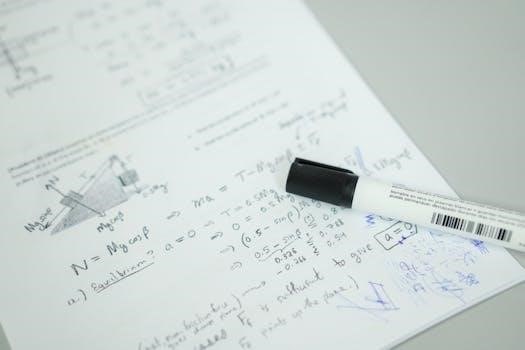FCTC Written Test⁚ A Comprehensive Study Guide
The Firefighter Candidate Testing Center (FCTC) Written Test evaluates critical thinking. Cal-JAC and FCTC are trusted sources for study materials. Prepare using their resources and sample questions.
What is the FCTC Written Test?
The FCTC Written Test is a standardized assessment used by fire departments to evaluate candidates. Developed by the California Firefighter Joint Apprenticeship Committee (Cal-JAC), it assesses a candidate’s ability to process information and think critically, skills essential for firefighting. The test goes beyond basic language and math, examining memory, mechanical reasoning, and problem-solving abilities.
The FCTC Written Test consists of multiple-choice questions. The test measures how candidates handle tasks of an entry-level firefighter. It includes questions designed to demonstrate the candidate’s ability to process information and think critically under pressure. The exam aims to ensure that only the most qualified applicants are considered for firefighter positions; Achieving a passing score is mandatory for inclusion on the Selection Eligibility List (SEL). The SEL is where fire agencies find their newest firefighter recruits.
Purpose and Importance of the FCTC Test
The FCTC Written Test serves as a crucial tool for fire departments in California, ensuring they select the most qualified candidates. Its primary purpose is to provide a standardized, objective assessment of essential skills and knowledge required for entry-level firefighters. The test evaluates a candidate’s ability to think critically, solve problems, and comprehend complex information.
By assessing these cognitive abilities, the FCTC Written Test helps departments identify individuals who can effectively handle the demands of the job. These demands include understanding technical manuals, making quick decisions in emergency situations, and working effectively as part of a team. A passing score on the FCTC Written Test is essential for candidates seeking a career in firefighting in California. It demonstrates a candidate’s readiness for the challenges of the profession.

Understanding the Test Structure
The FCTC Written Test has multiple-choice questions that assess key firefighter skills. The test includes sections that evaluate verbal comprehension, mechanical reasoning, mathematical abilities, and recall skills.
Four Sections of the FCTC Written Test
The FCTC Written Test is composed of four distinct sections designed to evaluate a candidate’s readiness for the demands of firefighting. The first section assesses recall and comprehension of technical information from written materials, which evaluates the ability to understand documents.
The second section tests mechanical reasoning and problem-solving skills, using fluid dynamics, levers, and gears. The third section focuses on mathematical abilities, including addition, division, angles, area, volume, decimals, ratios, and percentages. These skills are essential for calculating water pressure.
The final section involves video comprehension, where candidates watch videos of fire scenarios. Each section is designed to mirror real-world challenges faced by firefighters. By thoroughly preparing for each area, candidates can increase their chances of success. The study guide includes practice questions for each section.
Time Allocation and Test Duration
The FCTC Written Test is a timed examination designed to assess a candidate’s ability to perform under pressure. Candidates are allotted a total of two and a half hours (2.5 hours) to complete the 100 multiple-choice questions. This time frame includes a 30-minute period at the beginning, for candidates to read essays.
After the reading period, candidates have two hours to complete the test. Effective time management is crucial. It is important to allocate sufficient time to each section. Candidates should start with their strongest subject to build confidence and momentum.
Pacing yourself is vital. Don’t spend too much time on any single question. If you’re unsure, mark it and return later. Remember to use all the allocated time wisely, and review your answers if time permits. Practicing with sample tests will help you get used to the time constraints.

Key Skills Assessed
The FCTC Written Test assesses memory, mechanical reasoning, problem-solving, and mathematical skills. It evaluates a candidate’s ability to handle core firefighting tasks and process critical information effectively, accurately.
Recall and Comprehension of Information
This section of the FCTC Written Test evaluates a candidate’s ability to remember and understand information from written materials. It assesses how well test-takers can recall details, comprehend complex concepts, and draw logical conclusions from provided texts. This skill is essential for firefighters, who must quickly grasp information from reports, manuals, and instructions in high-pressure situations.
The questions in this section may involve passages on firefighting techniques, equipment operation, safety procedures, or incident reports. Candidates must demonstrate their ability to identify key facts, understand the main idea, and interpret the author’s intent. Effective strategies for this section include active reading, note-taking, and summarizing key points.
Practice with sample texts and questions can significantly improve performance. Focus on understanding the context and identifying the most important information. Additionally, expanding vocabulary and improving reading comprehension skills can enhance overall performance in this critical area of the FCTC Written Test. Remember, the ability to quickly and accurately recall and comprehend information is paramount for effective firefighting.
Mechanical Reasoning and Problem Solving
The Mechanical Reasoning and Problem Solving section of the FCTC Written Test assesses a candidate’s ability to understand mechanical principles and apply them to solve practical problems. This section evaluates knowledge of concepts such as fluid dynamics, levers, belts and pulleys, and gears. Firefighters often encounter situations requiring a solid grasp of mechanics, making this a crucial skill to assess.
The questions may involve scenarios where candidates must determine how mechanical systems work, identify potential problems, or propose solutions. Strong spatial reasoning and the ability to visualize mechanical processes are essential for success. Practice questions often involve diagrams and illustrations that require careful analysis.
To prepare for this section, review basic mechanical principles and practice solving problems involving various mechanical systems. Focus on understanding the relationship between force, motion, and energy. Familiarize yourself with common mechanical devices and their applications. By honing your mechanical reasoning and problem-solving skills, you can significantly improve your performance on this section of the FCTC Written Test.
Mathematical Abilities Required
The FCTC Written Test includes a section dedicated to assessing mathematical abilities, which are essential for various firefighting tasks. This section tests proficiency in fundamental mathematical concepts, including addition, subtraction, multiplication, and division. Candidates will also encounter questions involving decimals, ratios, percentages, angles, area, and volume.
These mathematical skills are critical for calculating water pressure, determining hose lengths, estimating distances, and managing resources effectively at emergency scenes. The questions are designed to evaluate a candidate’s ability to apply mathematical principles to real-world firefighting scenarios.
To prepare for this section, review basic mathematical concepts and practice solving problems that simulate firefighting-related situations. Focus on improving your speed and accuracy in performing calculations. Familiarize yourself with formulas for calculating area, volume, and other relevant measurements. Effective preparation in mathematical abilities will increase the likelihood of success on the FCTC Written Test. Utilize the FCTC study guide to improve mathematical abilities.

Effective Study Strategies
Utilize the official FCTC study guide, focusing on all four test sections. Practice with sample questions to improve understanding. Develop cognitive skills through wide reading and summarization.
Utilizing the Official FCTC Study Guide
The official FCTC study guide is an invaluable resource for preparing for the FCTC Written Test. This guide, created by FCTC, covers all four sections of the exam, offering study tips and sample questions designed to familiarize candidates with the test’s format and content.
Begin by thoroughly reviewing each section⁚ recall and comprehension, mechanical reasoning, and mathematical abilities. Pay close attention to the study tips provided, as they offer insights into the types of questions asked and effective strategies for answering them. Work through the sample questions, treating them as mini-practice tests to gauge your understanding and identify areas where further study is needed.
The guide also provides a framework for understanding the underlying concepts being tested. By mastering these concepts, you’ll be better equipped to tackle a wide range of questions, even those that differ from the sample questions. Remember, the FCTC study guide is your roadmap to success.
Practice Tests and Sample Questions
Practice tests and sample questions are vital tools in preparing for the FCTC Written Test. These resources allow candidates to familiarize themselves with the test format, question types, and time constraints. Utilize the sample questions within the official FCTC study guide to start. Treat these questions as mini-tests, simulating the actual exam environment.
Seek out additional practice tests from reputable sources. Be wary of unofficial materials, as Cal-JAC and FCTC are the only trusted providers; When taking practice tests, time yourself to simulate the real test conditions. Analyze your performance, identifying areas of strength and weakness. Focus on improving your understanding of the concepts behind the questions you missed.
Reviewing full score reports will help track your progress and refine your solving techniques. Remember, consistent practice is key to building confidence and improving your performance on the FCTC Written Test.

Test Taking Tips and Techniques
Effective test-taking involves time management and question strategies. Start with subjects you excel in. Pace yourself to allow for review and ensure all questions are attempted during the test.
Managing Time Effectively
Time management is crucial for success on the FCTC Written Test. Candidates are given a specific time limit to complete all sections, making efficient allocation essential. Begin by assessing the time available and dividing it among the four test sections, considering the number of questions and difficulty level of each.
Prioritize questions based on your strengths, tackling easier ones first to build confidence and momentum. If you encounter a challenging question, don’t dwell on it for too long; instead, mark it and return to it later if time permits. This prevents getting bogged down and ensures you address all questions.
Regularly monitor your progress against the clock. This will help you adjust your pace as needed and avoid running out of time before completing all sections. Remember, the FCTC Written Test is not a speed test, but it is timed, so maintaining a steady pace is essential. Effective time management allows you to review answers, increasing your chances of a higher score.
Strategies for Answering Multiple-Choice Questions
Mastering multiple-choice strategies is key to excelling on the FCTC Written Test. Begin by carefully reading each question and all answer options before selecting your response. Eliminate obviously incorrect answers to narrow down your choices and increase your probability of selecting the correct one.
Look for keywords or phrases in the question that provide clues to the correct answer. Pay attention to qualifiers like “always,” “never,” or “except,” as these can significantly alter the meaning of the question. If you’re unsure of the answer, use the process of elimination to rule out options that don’t fit.
Consider the context of the question and how it relates to the material covered in the FCTC study guide. If two options seem plausible, compare them carefully and look for subtle differences that might make one more correct than the other. Avoid overthinking, and trust your initial instinct unless you have a compelling reason to change your answer. Remember, each question is designed to assess your knowledge and critical thinking skills, so approach them methodically.

